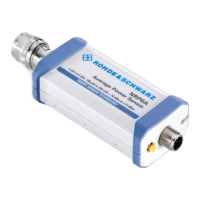R&S NRP Displaying data in the Scope mode
1144.1400.12 4.41 E-2
Displaying data in the Scope mode
Envelope power versus time can be graphically displayed in the Scope mode, allowing timeslot and
gate structures to be blended into the signal characteristic and configured. The average and peak
power values measured within a gate and the Peak/Avg ratio can be numerically displayed.
Switching the sensor to the Scope mode
To use the Scope mode display, the sensor must first be switched to a special operating mode (Scope)
and configured. This is done by way of the
Mode dialog box in the Sensor menu.
Mode dialog box:
T’gate, Scope… –
( )
ä↔ä
Fig. 4-35 Mode dialog box, Scope mode
Points – ( )
ä ä
Desired number of measurement points. Each point represents the
average power of a time interval whose width is determined by the
length of the measurement window ( Trace, p. 4.44) and the number
of measurement points.
Remote control
[SENSe[1..4]]:TRACe:POINts <int_value>
Reduced to
If the desired time resolution cannot be obtained with the connected
sensor, the number of measurement points is automatically reduced.
With the Sensors R&S NRP-Z1x and R&S NRP-Z2x, this limit is ap-
proximately 2.5 µs per measurement point (external triggering). 10 µs
is possible with internal triggering.
Realtime –
( )
ä
In the Realtime mode each measurement point comes from a single
sweep. Successively recorded traces are not averaged. For this pur-
pose, the chopper is switched off and the averaging filter deactivated.
Advantage: unstable or unclear trigger conditions are detected imme-
diately, preventing the display of unrealistic traces caused by averag-
ing asynchronous measurement values.
Disadvantage: if power is very low, display noise, zero offset and line-
arity are worse than in the Normal mode.
Remote control
[SENSe[1..4]]:TRACe:REALtime[?] ON | OFF
Mode : Scope

